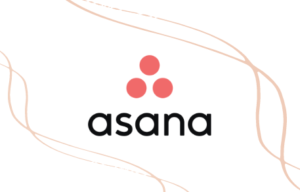
Asana is a web and mobile application designed to help teams manage their work and tasks. It provides a platform for team members to track projects, communicate, and collaborate with each other. Asana allows users to create tasks, assign them to team members, set due dates, add comments, and attach files, among other features. The goal of Asana is to improve team productivity and organization by streamlining workflows and reducing email and other forms of communication clutter.
Do you use sticky notes on your desk? Then it’s time to upgrade to this tool! 🙂
Asana is a great planner tool for recruiters if you are a highly visual type of person. Easy track and get notifications on everything that you are working on. We are great multi-taskers but having a tool like this can make you more highly organized.
It can be used be recruiters as an all-in-one place to track project updates, calendar meetings, manage tasks, and check up on other team projects that your recruiting team is working on. Step up systems and flows to upgrade and automate your overall recruiting productivity!
Getting started:
First go to the website: asana and get an account. They offer a free plan that is actually fairly decent. As you get more advanced you can then upgrade to the premium licenses. Once you sign up you will be directed to the dashboard page. The next steps will be to create a new project. You can create a blank project or use a template. When you select the project you will then be able to add individual tasks (including colors and icon).
You will then create a tasked that you want to complete and then add sub-tasks to work to get that completed. Within the tasks you can add an individual assignee to track the individual sub-task steps. You will then have to set due dates for each of these sub-tasks. If you hit tab-T on your keyboard you will be able to add tags with color options. You can either review your tasks in the list view, board view, or the calendar view.
The (color coded) calendar is great if you want to visualize and plan goals for each day, week, or month. In the dashboard click – tasks you will then see which tasks need to completed in order of the due date.
How can recruiters use asana?
Recruiters can use Asana to manage the recruitment process and keep track of candidate information, job requirements, and hiring timelines. Some ways recruiters can use Asana include:
1. Organizing candidate information: Recruiters can create tasks for each candidate, including their resume, cover letter, and interview notes.
2. Tracking interview schedules: Recruiters can create a project for each open position and use Asana to schedule and manage interviews with candidates.
3. Collaborating with team members: Recruiters can assign tasks to team members, share information, and get feedback on candidate qualifications, interview performance, and hiring decisions.
4. Monitoring hiring progress: Recruiters can use Asana to track the hiring process, from sourcing candidates to extending job offers.
5. Creating team projects: During this slow down recruiters can be assigned to projects in talent pipelining, employer branding, diversity hiring goals, or improving the recruiting processes as a whole.
How to create a candidate tracking pipeline in asana (using a template)?
The recruitment process can be challenging to manage, but with Asana, tracking candidates is made simple and efficient. The platform provides an easy way to keep track of the pipeline, store candidate information and resumes, and monitor the interview process. By having a streamlined workflow in Asana, companies can provide a positive experience for candidates.
Steps to Create a Candidate Tracking Project:
1. Create a project named “Candidate Tracking.” Add a description like, “Our pipeline of candidates for open positions across the company.”
3. Add a template task for each new candidate. Title the task as “[COPY ME] To add a candidate.” Provide instructions in the task description on how to rename the task, attach resumes and other relevant documents, and include the candidate’s contact information and source.
4. Use custom fields to track the position applied for, interview stage, and hiring status. Update these fields as candidates move through the process. Add custom fields by clicking the “Add Custom Fields” link at the top of the project.
5. Create sections in the project to categorize candidates by department or team, and add a section for declined or rejected candidates for reference.
6. Assign a project owner to manage the project. This person should move candidates to the appropriate section, assign tasks to the hiring manager, and use comments to ask follow-up questions. The recruiter can keep track of the candidate’s progress by updating the task.
Tips for managing your candidate tracking project
Add More Custom Fields: To gather more information about each candidate, you can create additional custom fields in Asana. For instance, you could add text fields for the candidate’s current city or personal website/portfolio.
Utilize Custom Fields: Custom fields are a powerful feature in Asana Premium that allows you to organize your candidate tracking project. You can start using them by signing up for a free Premium trial.
Set Reminder Tasks: If a candidate is not suitable for any current positions but may be a good fit in the future, create a task with a due date six months from today. This will prompt you to follow up with the candidate and keep them in your pipeline. You can store these candidates in a follow-up section or using a custom field.
Note: Only caveat about this – make sure that you are cleared with HR on data management compliance. Many companies have policies about personal and candidate data outside systems that cover security and retention. We all want to stay organized, but you have to weigh the risks.
Final Thoughts
You can use asana to track candidates through the full-cycle process, create projects for employer branding campaigns, or create a sourcing funnel for new prospect. Either way, asana is a great addition for recruiters or sourcers if you want to stay more productive and organized this year.
Recommended Reading:
Trish Wyderka Interview
How to deal with recruiting burnout
The best recruiting podcasts to listen to at work
- AI Search Will Transform Talent Sourcing Forever - January 10, 2025
- Build an AI Sourcing Assistant using ChatGPT 4 - January 10, 2025
- Top Recruiting Leaders to Follow in 2025 - January 8, 2025
